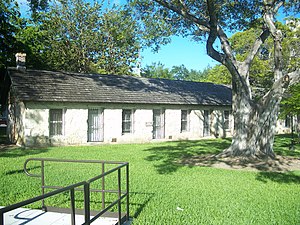Fort Dallas
| Fort Dallas | |
|---|---|
| Miami, Florida, United States | |

Barracks constructed in 1844, moved from Fort Dallas in 1924
|
|
| Type | Barracks |
| Site history | |
| Built | 1836 |
| In use | 1865 |
| Materials | stone |
Fort Dallas was a military base during the Seminole Wars, located on the banks of the Miami River in what is now downtown, Miami, Florida, United States.
Old Fort Dallas was established on the plantation of Richard Fitzpatrick and William English in 1836 as a United States military post and cantonment (and not as a fortification, although it is more than probable that there was a stockade surrounding it in its early days) in southern Florida during the Seminole Wars. In 1836, the U.S. Navy established patrols on Biscayne Bay to prevent trading between the Seminoles and traders from Cuba or the West Indies. Fort Dallas was established to support the Navy's efforts, but more pointedly, “for the purpose of harassing the enemy.” It was named in honor of Commodore Alexander James Dallas, United States Navy, then in command of the United States naval forces in the West Indies.
The first commandant was Lieutenant F. M. Powell, who remained in command about two years. Another noteworthy commander was U.S. Army Colonel William S. Harney (1839-1840) of the 2nd Dragoons who led an attack against Seminole chief Chakaika in 1840. From 1836 to 1857 it was occupied much of the time by troops, but was not a military reservation. Quite a number of buildings were erected, and today only two remain. In addition to these, there were a ten barracks, slave quarters, stables, and a blacksmith forge. The Post Surgeon occasionally took meteorological observations. During the tumultuous Seminole Wars, Fort Dallas not only provided the nervous Miami River settlers with a sense of security during the hostilities, but soldiers from the fort contributed to the development of the area. These early-to-mid-nineteenth century infrastructure expansions included a hospital, a road from Miami to Fort Lauderdale, and a trading post.
Fort Dallas remained in Union hands during the American Civil War and was abandoned afterward. During the war, the place was occupied by refugees from many places, and at the close of the war by a band of desperadoes. Judah P. Benjamin, who served as Attorney General, Secretary of War, and Secretary of State for the Confederacy, made his escape to Cuba through Indian River and Bay Biscayne. In describing the trip, he refers to the rough treatment he received at the hands of occupants of the fort, but, he added that it was a beautiful and picturesque spot, with its white houses and fine parade ground. The interior of the fort has been improved, and care has been taken to preserve the exterior unchanged.
...
Wikipedia
